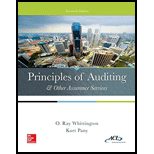
Hide-It (HI), a family-owned business based in Tombstone, Arizona, builds custom homes with special features, such as hidden rooms and hidden wall safes. Hide-It has been an audit client for three years.
You are about to sign off on a “clean” opinion on HI’s current annual financial statements when Art Hyde, the VP-Finance, calls to tell you that the Arizona Department of Revenue has seized control of a Hide-It bank account that includes about $450,000 of company funds; the account is not currently recorded in the accounting system and you had been unaware of it. In response to your questions about the origin of the funds, Art assures you that the funds, though not recorded as revenue, had been obtained legitimately. He explains that all of the money came from separately billed but unrecorded change orders to items in contracts completed before you became HI’s auditor, and before he or any members of current management became involved with the company. You subsequently determine that there is insufficient evidence to allow you to reconstruct the nature of these cash transactions, although the following analysis is available from the Arizona Department of Revenue:

Art also informs you that HI has agreed to pay a combined tax and penalty of 12 percent on the total funds deposited within 120 days as required by a recently enacted rule that provides amnesty for tax evaders. Furthermore, he states that negotiations with the Internal Revenue Service are in process.
Required:
- a. The professional standards define errors as unintentional misstatements or omissions of amounts or disclosures in the financial statements. Is the situation described an error?
- b. The professional standards state that fraud relates to intentional misstatements or omissions of amounts or disclosures in the financial statements. Misstatements due to fraud may occur due to either (1) fraudulent financial reporting or (2) misappropriation of assets. Does the situation appear to be fraud? If so, is it fraudulent financial reporting, misappropriation of assets, or both?
- c. The professional standards outline certain auditor responsibilities relating to identifying client noncompliance with laws and distinguish between laws with a “direct effect” on the financial statements and other laws. Does the situation herein relate to noncompliance with laws as discussed within the auditing standards? If so, is the noncompliance related to a law with a direct effect on the financial statements or another law.
- d. Should the CPA firm resign in this situation? If the decision is not clear-cut, what additional information would you desire before deciding?
Trending nowThis is a popular solution!

Chapter 2 Solutions
Principles of Auditing & Other Assurance Services (Irwin Accounting)
- Accounting question is correct answer with solutionarrow_forwardThe industrial enterprise "HUANG S.A." purchased a sorting and packaging machine from a foreign company on 1/4/2017 at a cost of €500,000. The useful life of the machine was estimated by the Management at ten (10) years, while the residual value was estimated at zero. For the transportation of the machine from abroad to the company's factory, the amount of €20,000 was paid on 15/4/2017. As the insurance coverage of the machine during transportation was the responsibility of the selling company, HUANG S.A. proceeded to insure the machine from 16/4/2017 to 15/4/2018, paying the amount of €1,200. The delivery took place on 15/4/2017. As adequate ventilation of the multifunction device is essential for its proper operation, the company fitted an air duct on the multifunction device. The cost of the air duct amounted to €2,000 and was paid on 20/4/2017. On 25/4/2017, an external electrician was paid €5,000 for the electrical connection of the device. The company also paid €5,000 to an…arrow_forwardprovide correct answer of this General accounting questionarrow_forward

 AccountingAccountingISBN:9781337272094Author:WARREN, Carl S., Reeve, James M., Duchac, Jonathan E.Publisher:Cengage Learning,
AccountingAccountingISBN:9781337272094Author:WARREN, Carl S., Reeve, James M., Duchac, Jonathan E.Publisher:Cengage Learning, Accounting Information SystemsAccountingISBN:9781337619202Author:Hall, James A.Publisher:Cengage Learning,
Accounting Information SystemsAccountingISBN:9781337619202Author:Hall, James A.Publisher:Cengage Learning, Horngren's Cost Accounting: A Managerial Emphasis...AccountingISBN:9780134475585Author:Srikant M. Datar, Madhav V. RajanPublisher:PEARSON
Horngren's Cost Accounting: A Managerial Emphasis...AccountingISBN:9780134475585Author:Srikant M. Datar, Madhav V. RajanPublisher:PEARSON Intermediate AccountingAccountingISBN:9781259722660Author:J. David Spiceland, Mark W. Nelson, Wayne M ThomasPublisher:McGraw-Hill Education
Intermediate AccountingAccountingISBN:9781259722660Author:J. David Spiceland, Mark W. Nelson, Wayne M ThomasPublisher:McGraw-Hill Education Financial and Managerial AccountingAccountingISBN:9781259726705Author:John J Wild, Ken W. Shaw, Barbara Chiappetta Fundamental Accounting PrinciplesPublisher:McGraw-Hill Education
Financial and Managerial AccountingAccountingISBN:9781259726705Author:John J Wild, Ken W. Shaw, Barbara Chiappetta Fundamental Accounting PrinciplesPublisher:McGraw-Hill Education





